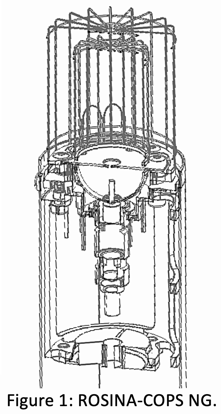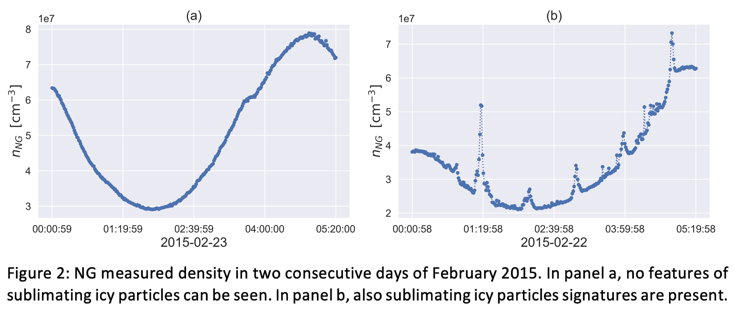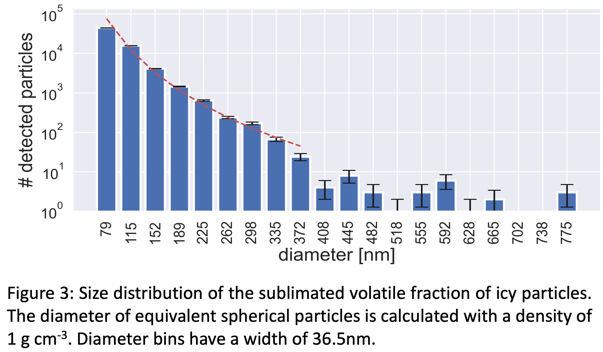Analysis of the sublimating volatiles in 67P/Churyumov-Gerasimenko coma particles starting from the ROSINA-COPS nude gauge data
- 1University of Bern, Physics Institute, Space Research & Planetary Sciences, Bern, Switzerland (boris.pestoni@space.unibe.ch)
- 2University of Bern, Center for Space and Habitability, Bern, Switzerland
Rosetta was a mission developed by the European Space Agency aimed at the prolonged study of a remnant of the Solar System formation: the Jupiter-family comet 67P/Churyumov-Gerasimenko (hereafter, 67P). After ten years of travel, on 6 August 2014 the Rosetta spacecraft arrived at its target and an observation campaign of almost two years started.
The spacecraft was equipped with various instruments designed to analyze cometary dust in 67P's coma, such as the Micro-Imaging Dust Analysis System (MIDAS; Riedler et al. 2007), the Grain Impact Analyzer and Dust Accumulator (GIADA; Colangeli et al. 2007), and the COmetary Secondary Ion Mass Analyser (COSIMA; Kissel et al. 2007). In Pestoni et al. (2021), we demonstrated that, although not designed for this purpose, also the ram gauge (RG) of the Rosetta Orbiter Spectrometer for Ion and Neutral Analysis COmet Pressure Sensor (ROSINA-COPS; Balsiger et al. 2007) may be used to obtain information on the cometary dust, namely its volatile content. This was possible as the RG reported abruptly density increases generated by the sublimation of the ice fraction of cometary particles impacting the instrument.
We show that also the second gauge of ROSINA-COPS, the nude gauge (NG, see Figure 1), can obtain information about 67P dust particles (Pestoni et al. 2021, accepted for publication on A&A).

With the same procedure employed to extract sublimation features from the RG measurement dataset, 67000 sublimation features are discovered in the NG measurements. For the RG features, a fit of the density decrease back to nominal values was performed (Pestoni et al. 2021). This is not possible for the NG features, as the latter have a much shorter duration (see panel b of Figure 2). The dissimilar duration of the sublimation signatures is due to the different designs of the two gauges (Balsiger et al. 2007); in fact, the open design of the NG does not prevent volatiles from escaping the instrument. Therefore, only the feature height over the nominal background can be extracted from the NG data. Nevertheless, we perform several statistical analyses by relating the number of detections and the features height with the heliocentric and cometocentric distances, parameters related to the ROSINA-COPS orientation to 67P, as well as water production rates and dust brightnesses obtained from previous studies, such as Snodgrass et al. (2016) and Hansen et al. (2016).

It is found that the NG detection rate is strongly correlated to 67P cometary gas activity and that the shedding of a cover of dust during the 67P approach to perihelion (Schulz et al. 2015) can be extended to the volatile content as well. Moreover, by representing the sublimating volatile contents as equivalent spheres having a density of 1 g cm-3, diameters between 60 and 793 nanometers are derived (see Figure 3). The equivalent spheres with a diameter lower than 390 nanometers have a size distribution power index (-4.79±0.26) which is smaller than those obtained by the aforementioned instruments dedicated to the observation of dust, cf. Rotundi et al. (2015), Moreno et al. (2016), and Merouane et al. (2016).

References
Balsiger, H., Altwegg, K., Bochsler, P. et al. 2007, Space Sci. Rev., 128, 745
Colangeli, L., Lopez Moreno, J. J., Palumbo, P., et al. 2007, Advances in Space Research, 39, 446
Hansen, K. C., Altwegg, K., Berthelier, J. J., et al. 2016, MNRAS, 462, S491
Kissel, J., Altwegg, K., Clark, B. C., et al. 2007, Space Sci. Rev., 128, 823
Merouane, S., Zaprudin, B., Stenzel, O., et al. 2016, A&A, 596, A87
Moreno, F., Snodgrass, C., Hainaut, O., et al. 2016, A&A, 587, A155
Pestoni, B., Altwegg, K., Balsiger, H., et al. 2021, A&A, 645, A38
Pestoni, B., Altwegg, K., Balsiger, H., et al. 2021, accepted for publication on A&A
Riedler, W., Torkar, K., Jeszenszky, H., et al. 2007, Space Sci. Rev., 128, 869
Rotundi, A., Sierks, H., Della Corte, V., et al. 2015, Science, 347, aaa3905
Schulz, R., Hilchenbach, M., Langevin, Y., et al. 2015, Nature, 518, 216
Snodgrass, C., Opitom, C., de Val-Borro, M., et al. 2016, MNRAS, 462, S138
How to cite: Pestoni, B., Altwegg, K., Hänni, N., Rubin, M., and Wampfler, S.: Analysis of the sublimating volatiles in 67P/Churyumov-Gerasimenko coma particles starting from the ROSINA-COPS nude gauge data, European Planetary Science Congress 2021, online, 13–24 Sep 2021, EPSC2021-513, https://doi.org/10.5194/epsc2021-513, 2021.

